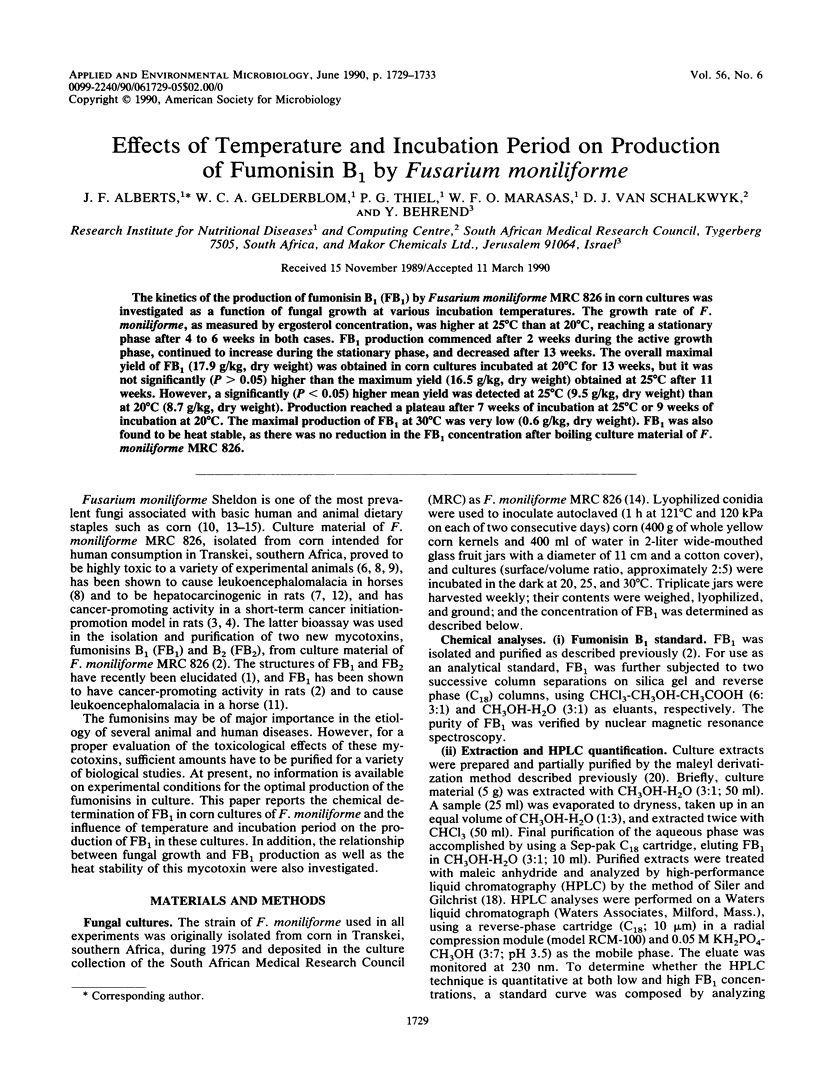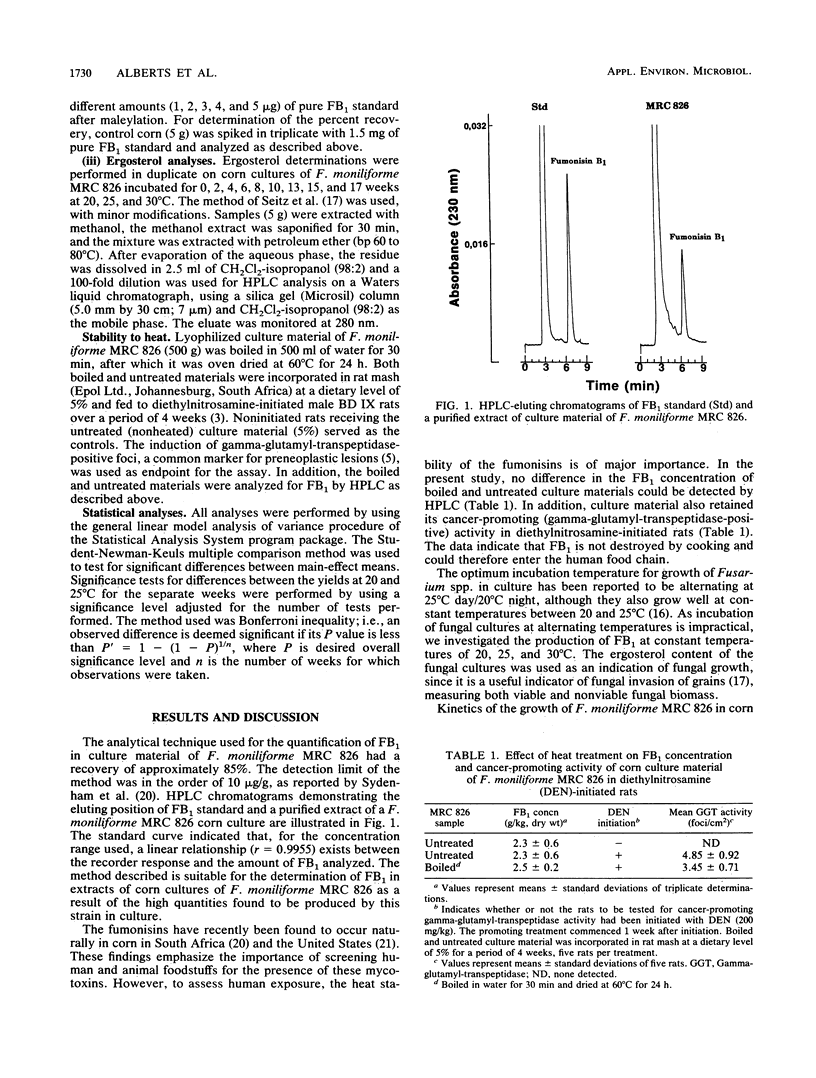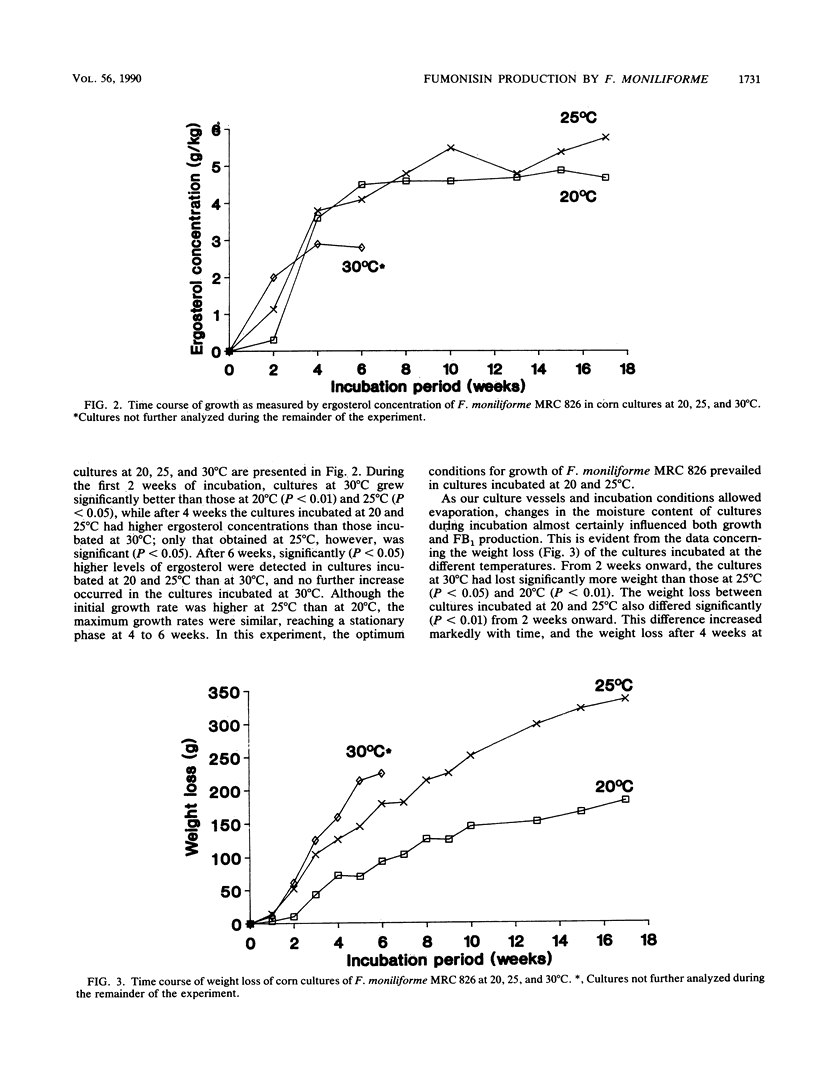Abstract
The kinetics of the production of fumonisin B1 (FB1) by Fusarium moniliforme MRC 826 in corn cultures was investigated as a function of fungal growth at various incubation temperatures. The growth rate of F. moniliforme, as measured by ergosterol concentration, was higher at 25 degrees C than at 20 degrees C, reaching a stationary phase after 4 to 6 weeks in both cases. FB1 production commenced after 2 weeks during the active growth phase, continued to increase during the stationary phase, and decreased after 13 weeks. The overall maximal yield of FB1 (17.9 g/kg, dry weight) was obtained in corn cultures incubated at 20 degrees C for 13 weeks, but it was not significantly (P greater than 0.05) higher than the maximum yield (16.5 g/kg, dry weight) obtained at 25 degrees C after 11 weeks. However, a significantly (P less than 0.05) higher mean yield was detected at 25 degrees C (9.5 g/kg, dry weight) than at 20 degrees C (8.7 g/kg, dry weight). Production reached a plateau after 7 weeks of incubation at 25 degrees C or 9 weeks of incubation at 20 degrees C. The maximal production of FB1 at 30 degrees C was very low (0.6 g/kg, dry weight). FB1 was also found to be heat stable, as there was no reduction in the FB1 concentration after boiling culture material of F. moniliforme MRC 826.
Full text
PDF




Selected References
These references are in PubMed. This may not be the complete list of references from this article.
- Gelderblom W. C., Jaskiewicz K., Marasas W. F., Thiel P. G., Horak R. M., Vleggaar R., Kriek N. P. Fumonisins--novel mycotoxins with cancer-promoting activity produced by Fusarium moniliforme. Appl Environ Microbiol. 1988 Jul;54(7):1806–1811. doi: 10.1128/aem.54.7.1806-1811.1988. [DOI] [PMC free article] [PubMed] [Google Scholar]
- Gelderblom W. C., Marasas W. F., Jaskiewicz K., Combrinck S., van Schalkwyk D. J. Cancer promoting potential of different strains of Fusarium moniliforme in a short-term cancer initiation/promotion assay. Carcinogenesis. 1988 Aug;9(8):1405–1409. doi: 10.1093/carcin/9.8.1405. [DOI] [PubMed] [Google Scholar]
- Gelderblom W. C., Thiel P. G., Jaskiewicz K., Marasas W. F. Investigations on the carcinogenicity of fusarin C--a mutagenic metabolite of Fusarium moniliforme. Carcinogenesis. 1986 Nov;7(11):1899–1901. doi: 10.1093/carcin/7.11.1899. [DOI] [PubMed] [Google Scholar]
- Hanigan M. H., Pitot H. C. Gamma-glutamyl transpeptidase--its role in hepatocarcinogenesis. Carcinogenesis. 1985 Feb;6(2):165–172. doi: 10.1093/carcin/6.2.165. [DOI] [PubMed] [Google Scholar]
- Jaskiewicz K., Marasas W. F., Taljaard J. J. Hepatitis in vervet monkeys caused by Fusarium moniliforme. J Comp Pathol. 1987 May;97(3):281–291. doi: 10.1016/0021-9975(87)90092-2. [DOI] [PubMed] [Google Scholar]
- Jaskiewicz K., van Rensburg S. J., Marasas W. F., Gelderblom W. C. Carcinogenicity of Fusarium moniliforme culture material in rats. J Natl Cancer Inst. 1987 Feb;78(2):321–325. [PubMed] [Google Scholar]
- Kriek N. P., Kellerman T. S., Marasas W. F. A comparative study of the toxicity of Fusarium verticillioides (= F. moniliforme) to horses, primates, pigs, sheep and rats. Onderstepoort J Vet Res. 1981 Jun;48(2):129–131. [PubMed] [Google Scholar]
- Kriek N. P., Marasas W. F., Thiel P. G. Hepato- and cardiotoxicity of Fusarium verticillioides (F. moniliforme) isolates from Southern African maize. Food Cosmet Toxicol. 1981 Aug;19(4):447–456. doi: 10.1016/0015-6264(81)90449-1. [DOI] [PubMed] [Google Scholar]
- Marasas W. F., Jaskiewicz K., Venter F. S., Van Schalkwyk D. J. Fusarium moniliforme contamination of maize in oesophageal cancer areas in Transkei. S Afr Med J. 1988 Aug 6;74(3):110–114. [PubMed] [Google Scholar]
- Marasas W. F., Kellerman T. S., Gelderblom W. C., Coetzer J. A., Thiel P. G., van der Lugt J. J. Leukoencephalomalacia in a horse induced by fumonisin B1 isolated from Fusarium moniliforme. Onderstepoort J Vet Res. 1988 Dec;55(4):197–203. [PubMed] [Google Scholar]
- Marasas W. F., Kriek N. P., Fincham J. E., van Rensburg S. J. Primary liver cancer and oesophageal basal cell hyperplasia in rats caused by Fusarium moniliforme. Int J Cancer. 1984 Sep 15;34(3):383–387. doi: 10.1002/ijc.2910340315. [DOI] [PubMed] [Google Scholar]
- Voss K. A., Norred W. P., Plattner R. D., Bacon C. W. Hepatotoxicity and renal toxicity in rats of corn samples associated with field cases of equine leukoencephalomalacia. Food Chem Toxicol. 1989 Feb;27(2):89–96. doi: 10.1016/0278-6915(89)90002-1. [DOI] [PubMed] [Google Scholar]


